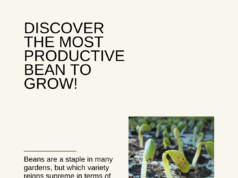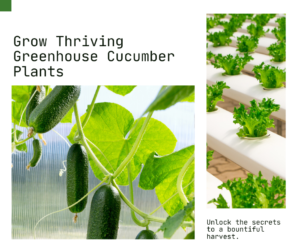
Welcome to our comprehensive guide on successfully growing cucumber plants in a greenhouse. Whether you’re a seasoned gardener or just starting out, this guide will provide you with expert tips and techniques to ensure your cucumber plants thrive in a greenhouse environment.
Growing cucumbers in a greenhouse offers numerous benefits. It allows you to extend the growing season, protect your plants from harsh weather conditions, and create optimal conditions for healthy growth. With the right knowledge and care, you can enjoy a bountiful harvest of delicious cucumbers right at your fingertips.
Key Takeaways:
- Learn everything you need to know about growing cucumber plants in a greenhouse
- Discover expert tips and techniques for optimal growing conditions
- Select the right cucumber varieties suited for greenhouse cultivation
- Create the ideal growing environment with proper temperature, humidity, light, and ventilation
- Master watering techniques and nutrient management for healthy cucumber plants
An Introduction to Greenhouse Cucumber Plants
Before diving into the details, let’s start with an overview of greenhouse cucumber plants. Growing cucumbers in a greenhouse offers numerous benefits and has become a popular choice among gardeners.
Firstly, greenhouse cultivation provides a controlled environment that allows you to extend the growing season and grow cucumbers all year round. This is especially advantageous in regions with shorter summers or unpredictable weather conditions.
Secondly, growing cucumbers in a greenhouse protects the plants from pests, diseases, and harsh environmental factors. By creating a favorable microclimate, you can ensure the optimal conditions for cucumber growth and minimize risks.
Furthermore, greenhouse-grown cucumbers tend to have higher yields and superior quality compared to field-grown ones. The controlled environment allows for precise monitoring of temperature, humidity, and other crucial factors that directly impact plant health and productivity.
“Greenhouse cultivation provides a controlled environment that allows you to extend the growing season and grow cucumbers all year round.”
In addition to these advantages, greenhouse cucumber plants can also be trained to grow vertically, saving space and making harvesting easier. This vertical growth method not only maximizes yield but also ensures better air circulation and light penetration, promoting healthier plants and reducing the risk of disease.
Now that you have an overview of greenhouse cucumber plants, you’re ready to delve into the details of successful cultivation. In the next section, we’ll explore the process of selecting the right cucumber varieties for greenhouse growing.
Choosing the Right Cucumber Varieties for Greenhouse Cultivation
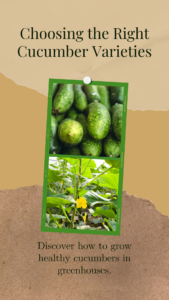
When it comes to greenhouse cultivation, selecting the right cucumber varieties is a crucial step towards a successful harvest. Factors such as plant growth habit, disease resistance, and fruit quality should all be considered. To help you make the best choice, here are some key factors to consider when selecting cucumber varieties for your greenhouse.
Factors to Consider when Selecting Cucumber Varieties
- Plant Type: Determine whether you prefer bush cucumbers or vining cucumbers. Bush cucumbers are compact and suitable for smaller greenhouse setups, while vining cucumbers require trellising and offer higher yields.
- Days to Maturity: Consider the growing season and desired harvest timeline. Some cucumber varieties mature faster than others, so choose varieties that align with your greenhouse’s climate and your desired timeline.
- Growing Space: Assess the available space in your greenhouse. If your greenhouse has limited vertical space, look for cucumber varieties that have a more compact growth habit.
- Disease Resistance: Check the disease resistance ratings for each variety. Choosing cucumber varieties with resistance to common diseases like powdery mildew and cucumber mosaic virus can help ensure healthier plants and higher yields.
- Fruit Quality: Consider your preferences for fruit size, shape, and taste. Some cucumber varieties are known for their crunchy texture and mild flavor, while others may have a sweeter taste.
Best Cucumber Varieties for Greenhouse Cultivation
Here are some of the best cucumber varieties that are well-suited for greenhouse growing:
| Variety | Type | Days to Maturity | Disease Resistance | Fruit Characteristics |
|---|---|---|---|---|
| English Telegraph | Vining | 60-70 days | Powdery Mildew, Cucumber Mosaic Virus | Long, slender fruits with a crisp texture |
| Marketer | Vining | 60-70 days | Powdery Mildew, Cucumber Mosaic Virus | Smooth, dark green fruits with a refreshing taste |
| Salad Bush | Bush | 55-60 days | Powdery Mildew, Cucumber Mosaic Virus | Compact plants with crisp, bite-sized fruits |
| Patio Pik | Bush | 55-60 days | Powdery Mildew, Cucumber Mosaic Virus | Perfect for container gardening, small fruits with excellent flavor |
Experimenting with different cucumber varieties can be a rewarding experience, allowing you to discover your favorites for both flavor and performance. Remember to provide the appropriate support, maintain optimal growing conditions, and monitor your greenhouse regularly to ensure the success of your cucumber plants. With the right varieties, you’ll be rewarded with a bountiful harvest of delicious, homegrown cucumbers.
Creating the Ideal Growing Environment for Greenhouse Cucumbers
Creating the perfect growing environment is essential for the successful cultivation of cucumber plants in a greenhouse. By understanding and meeting the temperature and humidity requirements, as well as optimizing light and ventilation, you can ensure that your cucumber plants thrive and produce abundant yields.
Temperature and humidity play crucial roles in the growth and development of greenhouse cucumbers. Maintaining a temperature range of 75°F to 80°F (24°C to 27°C) during the day and 65°F to 70°F (18°C to 21°C) at night is ideal for optimal growth. It’s essential to monitor and regulate the temperature using ventilation systems, shading, and heating devices. Additionally, maintaining a humidity level of 60% to 80% helps create a favorable microclimate for cucumber plants, preventing issues like leaf wilting and fungal diseases.
Optimizing light and ventilation is another key aspect of creating an ideal growing environment for greenhouse cucumbers. These plants require at least 12 to 14 hours of bright, direct sunlight each day. In situations where natural sunlight is insufficient, supplemental lighting can be provided using high-quality grow lights. Adequate ventilation is also crucial to prevent the buildup of excessive heat and humidity. Consider using vents, fans, and vents to ensure proper air circulation and reduce the risk of diseases.
“The ideal growing environment for greenhouse cucumbers is a delicate balance of temperature, humidity, light, and ventilation. By providing the optimal conditions, you can ensure vigorous growth, disease resistance, and bountiful harvests.”
Remember, each cucumber variety may have specific environmental preferences, so it’s essential to research and understand the requirements of the specific varieties you choose to cultivate. Creating the perfect growing environment and maintaining it consistently will set the foundation for healthy, productive cucumber plants in your greenhouse.
Proper Watering and Nutrient Management for Greenhouse Cucumbers
When it comes to cultivating thriving cucumber plants in a greenhouse, proper watering and nutrient management are essential. Providing your plants with the right amount of water and essential nutrients not only promotes robust growth but also ensures a bountiful harvest. In this section, we will explore the best watering techniques for greenhouse cucumber plants and provide you with valuable tips on nutrient management.
Watering Techniques for Greenhouse Cucumber Plants
Greenhouse cucumber plants have specific watering requirements that differ from those grown in the field. Here are some helpful techniques to keep your plants hydrated and healthy:
- Monitor soil moisture: Regularly check the moisture level of the soil to determine when your cucumber plants need water. Insert your finger about an inch into the soil – if it feels dry, it’s time to water.
- Water deeply and infrequently: When watering cucumber plants, it’s important to provide deep, thorough watering. This encourages the roots to grow deeper into the soil, resulting in stronger, more resilient plants.
- Avoid overwatering: While it’s crucial to keep cucumber plants hydrated, excessive moisture can lead to root rot and other diseases. Ensure proper drainage in your greenhouse and avoid overwatering to prevent these issues.
- Consider drip irrigation: Drip irrigation is an efficient method for watering greenhouse cucumbers. It delivers water directly to the plant’s root zone, reducing the risk of fungal diseases and water waste.
Essential Nutrients and Fertilization Tips
Proper nutrient management is vital for the healthy growth of greenhouse cucumber plants. Here are some essential nutrients and fertilization tips to optimize plant growth:
| Nutrient | Function |
|---|---|
| Nitrogen | Stimulates leaf and stem growth |
| Phosphorus | Promotes root development and flowering |
| Potassium | Aids in fruit formation and overall plant health |
| Calcium | Prevents blossom end rot and strengthens cell walls |
To ensure your cucumber plants receive these essential nutrients, consider using a balanced fertilizer specifically formulated for greenhouse crops. Follow the manufacturer’s instructions for application rates and timing. Additionally, it’s beneficial to regularly test your soil’s nutrient levels to make informed fertilization decisions.
Remember, maintaining proper watering techniques and nutrient management is crucial for the success of your greenhouse cucumber plants. By providing the ideal growing conditions and essential nutrients, you’ll be rewarded with healthy plants that produce abundant, delicious cucumbers for your enjoyment.
Pest and Disease Control for Greenhouse Cucumbers
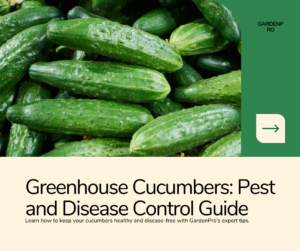
Cucumber plants in greenhouses are susceptible to various pests and diseases that can hinder their growth and productivity. It’s essential to implement effective pest and disease control measures to ensure the health and longevity of your cucumber plants. By being proactive and using organic solutions, you can minimize the risk of pests and diseases and maintain a thriving cucumber crop.
Common Pests and Diseases Affecting Greenhouse Cucumbers
Here are some of the common pests and diseases that can affect greenhouse cucumbers:
- Aphids – These small insects feed on the sap of cucumber plants, causing curling leaves and stunted growth.
- Whiteflies – Whiteflies can quickly infest cucumber plants, leading to yellowing leaves and the spread of viral diseases.
- Spider mites – These tiny pests create webbing on the leaves and suck the plant’s juices, resulting in yellowed and shriveled foliage.
- Powdery mildew – This fungal disease forms a white powdery coating on the leaves, inhibiting photosynthesis and reducing plant vigor.
- Downy mildew – Another fungal disease that causes yellow patches on the leaves and affects the plant’s overall health and productivity.
Proper identification of pests and diseases is crucial for effective control. Regular monitoring of your cucumber plants and early detection of problems can help prevent widespread infestations.
Preventive Measures and Organic Solutions
Implementing preventive measures is the first line of defense against pests and diseases in greenhouse cucumber plants. Here are some strategies to consider:
- Sanitation: Keep your greenhouse clean and free from debris to eliminate potential breeding grounds for pests and diseases.
- Plant spacing: Adequate spacing between cucumber plants allows for better air circulation, reducing humidity and minimizing the risk of fungal diseases.
- Biological control: Introduce beneficial insects such as ladybugs, lacewings, or parasitic wasps that prey on common pests like aphids and whiteflies.
- Companion planting: Grow companion plants like marigolds, basil, or dill in and around your cucumber beds to repel pests.
- Organic sprays: Use organic insecticides or fungicides formulated for greenhouse crops, following the manufacturer’s instructions for safe and effective application.
| Pest/Disease | Symptoms | Prevention | Control |
|---|---|---|---|
| Aphids | Curling leaves, stunted growth | Plant resistant varieties, encourage beneficial insects | Spray neem oil or insecticidal soap, manually remove aphids |
| Whiteflies | Yellowing leaves, viral diseases | Use yellow sticky traps, spray insecticidal soap | Release parasitic wasps, control weeds around the greenhouse |
| Spider mites | Webbing, yellowed and shriveled foliage | Maintain humidity below 50%, introduce predatory mites | Spray horticultural oil or insecticidal soap, remove infested leaves |
| Powdery mildew | White powdery coating on leaves | Proper air circulation, avoid overhead watering | Spray diluted milk solution, apply organic fungicides |
| Downy mildew | Yellow patches on leaves | Avoid overhead watering, good ventilation | Spray copper-based fungicides, remove affected leaves |
Implementing preventive measures and using organic solutions can help keep your greenhouse cucumbers healthy and productive. Regular monitoring, early intervention, and maintaining optimal growing conditions are key to successful pest and disease control. By following these strategies, you can minimize the risk and enjoy a flourishing cucumber harvest.
Harvesting and Maintenance of Greenhouse Cucumber Plants
When it comes to cultivating greenhouse cucumber plants, knowing when and how to harvest the fruits is crucial for achieving the best flavor and texture. Additionally, implementing proper pruning, training, and maintenance techniques will ensure that your plants thrive throughout their growing season.
Signs of Readiness for Harvesting Cucumber Fruits
To determine if your cucumber fruits are ready for harvesting, keep an eye out for the following signs:
- Firmness: Gently squeeze the cucumber, and if it feels firm and crisp, it is likely ready to be harvested.
- Size: Cucumbers should reach their mature size, which varies depending on the cultivar. Refer to the seed packet or label for specific size indications.
- Color: Most cucumber varieties turn a vibrant shade of green when ripe, while others may have a yellow or white color.
- No spines: Mature cucumbers typically have fewer or no spines on their skin.
It’s important to harvest cucumbers as soon as they reach maturity to maintain the plant’s productivity. Leaving overripe cucumbers on the vine can signal the plant to stop producing more fruits.
Pruning, Training, and Maintenance Techniques for Thriving Plants
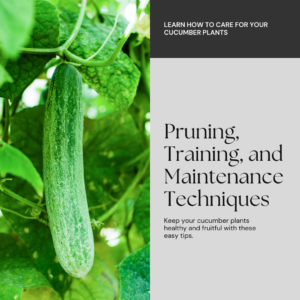
Pruning the cucumber plants helps manage their growth and improves air circulation, which reduces the risk of pest and disease problems. Remove any yellow or wilted leaves, as they can attract pests and negatively impact the plant’s health.
Tip: Regularly inspect your cucumber plants for signs of pests or diseases, and take immediate action if you notice any issues. Early intervention is key to preventing the spread of problems and protecting the overall health of your plants.
Training cucumber plants on trellises or support structures helps keep the vines off the ground, allowing better air circulation and preventing fruit rot. As the plants grow, gently guide the vines and secure them to the trellis using soft twine or plant clips.
Regular maintenance tasks, such as removing weeds, providing adequate water, and applying fertilizers, are essential to keep your greenhouse cucumber plants healthy and productive. By maintaining proper moisture levels and providing regular feeding, you can ensure optimal growth and high yields.
| Maintenance Task | Frequency | Benefits |
|---|---|---|
| Weeding | Ongoing | Prevents competition for nutrients and reduces pest habitats. |
| Watering | Consistently, when needed | Maintains proper moisture levels for plant growth and fruit development. |
| Fertilizing | As directed by the fertilizer label | Ensures plants receive essential nutrients for robust growth and high yields. |
| Pest and Disease Monitoring | Regularly | Allows for early detection and timely treatment of any problems. |
FAQ
Q. What are the benefits of growing cucumbers in a greenhouse?
A. Growing cucumbers in a greenhouse provides several benefits, such as extending the growing season, protecting plants from harsh weather conditions, reducing the risk of pests and diseases, and increasing control over the growing environment.
Q. What factors should I consider when selecting cucumber varieties for greenhouse cultivation?
A. When selecting cucumber varieties for greenhouse cultivation, factors such as growth habit, disease resistance, yield potential, and fruit quality should be considered. It’s also important to choose varieties suited for greenhouse conditions, such as compact or parthenocarpic varieties.
Q. Which are the best cucumber varieties for greenhouse cultivation?
A. Some of the best cucumber varieties for greenhouse cultivation include ‘Miniature White’, ‘Sweet Success’, ‘Thunder’, ‘Diva’, and ‘Socrates’. These varieties are known for their high yields, disease resistance, and excellent flavor.
Q. What are the temperature and humidity requirements for greenhouse cucumbers?
A. Greenhouse cucumbers thrive in temperatures between 75°F and 85°F (24°C and 29°C) during the day and slightly cooler temperatures at night. The humidity level should be around 60% to 70% to prevent leaf diseases and facilitate fruit set.
Q. How can I optimize light and ventilation in my greenhouse for cucumber plants?
A. To optimize light in the greenhouse, ensure that the cucumbers receive at least 6 hours of direct sunlight or provide supplemental lighting. Good ventilation is also essential to prevent excessive heat and humidity buildup. Use ridge vents, side ventilation, or fans to promote air circulation.
Q. What are the proper watering techniques for greenhouse cucumber plants?
A. Water greenhouse cucumber plants regularly, keeping the soil evenly moist but not waterlogged. Avoid wetting the foliage to prevent leaf diseases. Drip irrigation or soaker hoses are ideal watering methods, delivering water directly to the plant roots while minimizing moisture on the leaves.
Q. What essential nutrients should I provide to greenhouse cucumber plants, and how can I fertilize them?
A. Greenhouse cucumber plants require a balanced fertilizer containing nitrogen (N), phosphorus (P), and potassium (K), as well as micronutrients. Fertilize them every two weeks during active growth using a liquid or water-soluble fertilizer. Follow the manufacturer’s instructions and monitor the plant’s response to avoid overfertilization.
Q. What are some common pests and diseases that affect greenhouse cucumbers, and how can I control them?
A. Common pests that affect greenhouse cucumbers include aphids, spider mites, and whiteflies, while diseases like powdery mildew and bacterial wilt can pose challenges. Control these pests and diseases by implementing preventive measures such as regular monitoring, maintaining proper plant spacing, using beneficial insects, and applying organic solutions like neem oil or insecticidal soap.
Q. How can I determine when cucumber fruits are ready for harvesting, and what pruning and maintenance techniques are recommended?
A. Cucumber fruits are ready for harvesting when they reach their mature size and have a bright color. Check the specific variety’s recommendation for optimal harvest size. Prune cucumber plants by removing lateral shoots and maintaining a single main stem. Regularly inspect and remove any diseased or damaged leaves to promote plant health.
Conclusion
In conclusion, growing cucumber plants in a greenhouse can be a rewarding experience. By following the tips and techniques outlined in this guide, you’ll be well on your way to cultivating thriving cucumber plants and enjoying a bountiful harvest.
Throughout this comprehensive guide, we have covered everything you need to know about successfully growing cucumber plants in a greenhouse. From choosing the right cucumber varieties to creating the ideal growing environment, proper watering and nutrient management, pest and disease control, and harvesting and maintenance techniques – each aspect has been thoroughly explored.
By implementing the strategies discussed, you can create an optimal environment for your cucumber plants, ensuring they receive the right conditions for healthy growth. With attention to detail and regular maintenance, you’ll be rewarded with abundant cucumber harvests throughout the growing season.
So, whether you’re an experienced gardener looking to enhance your greenhouse cultivation or a beginner wanting to try your hand at growing cucumbers, this guide has provided you with the knowledge and tools to succeed. With a little care and dedication, your greenhouse cucumbers will thrive, providing you with delicious, homegrown produce.







